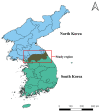Modelling the Spatial Distribution of ASF-Positive Wild Boar Carcasses in South Korea Using 2019-2020 National Surveillance Data
- PMID: 33922261
- PMCID: PMC8145688
- DOI: 10.3390/ani11051208
Modelling the Spatial Distribution of ASF-Positive Wild Boar Carcasses in South Korea Using 2019-2020 National Surveillance Data
Abstract
In September 2019, African swine fever (ASF) was reported in South Korea for the first time. Since then, more than 651 ASF cases in wild boars and 14 farm outbreaks have been notified in the country. Despite the efforts to eradicate ASF among wild boar populations, the number of reported ASF-positive wild boar carcasses have increased recently. The purpose of this study was to characterize the spatial distribution of ASF-positive wild boar carcasses to identify the risk factors associated with the presence and number of ASF-positive wild boar carcasses in the affected areas. Because surveillance efforts have substantially increased in early 2020, we divided the study into two periods (2 October 2019 to 19 January 2020, and 19 January to 28 April 2020) based on the number of reported cases and aggregated the number of reported ASF-positive carcasses into a regular grid of hexagons of 3-km diameter. To account for imperfect detection of positive carcasses, we adjusted spatial zero-inflated Poisson regression models to the number of ASF-positive wild boar carcasses per hexagon. During the first study period, proximity to North Korea was identified as the major risk factor for the presence of African swine fever virus. In addition, there were more positive carcasses reported in affected hexagons with high habitat suitability for wild boars, low heat load index (HLI), and high human density. During the second study period, proximity to an ASF-positive carcass reported during the first period was the only significant risk factor for the presence of ASF-positive carcasses. Additionally, low HLI and elevation were associated with an increased number of ASF-positive carcasses reported in the affected hexagons. Although the proportion of ASF-affected hexagons increased from 0.06 (95% credible interval (CrI): 0.05-0.07) to 0.09 (95% CrI: 0.08-0.10), the probability of reporting at least one positive carcass in ASF-affected hexagons increased from 0.49 (95% CrI: 0.41-0.57) to 0.73 (95% CrI: 0.66-0.81) between the two study periods. These results can be used to further advance risk-based surveillance strategies in the Republic of Korea.
Keywords: African swine fever; Korea; spatial epidemiology; surveillance; wild boar.
Conflict of interest statement
The authors declare no conflict of interest.
Figures






References
-
- Luskin M.S., Meijaard E., Surya S., Sheherazade , Walzer C., Linkie M. African Swine Fever threatens Southeast Asia’s 11 endemic wild pig species. Conserv. Lett. 2020 doi: 10.1111/conl.12784. - DOI
-
- Dellicour S., Desmecht D., Paternostre J., Malengreaux C., Licoppe A., Gilbert M., Linden A., Park A. Unravelling the dispersal dynamics and ecological drivers of the African swine fever outbreak in Belgium. J. Appl. Ecol. 2020;57:1619–1629. doi: 10.1111/1365-2664.13649. - DOI
Grants and funding
LinkOut - more resources
Full Text Sources
Miscellaneous

